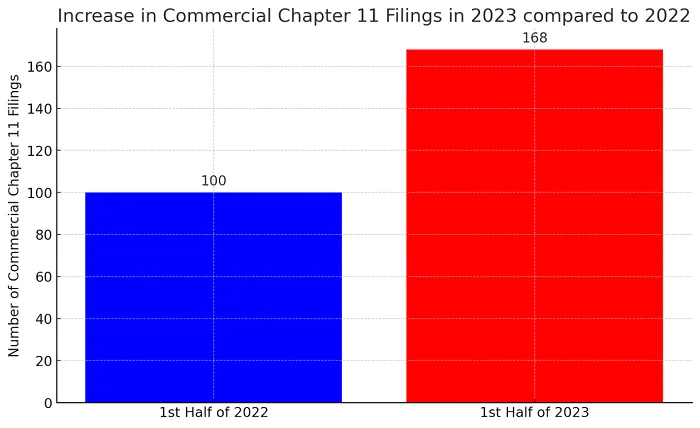In 2023, the commercial landscape is witnessing a seismic shift. The surge in commercial Chapter 11 filings, a staggering 68% increase in the first half of this year compared to 2022, paints a vivid picture of the challenges businesses face in the realm of commercial liquidation. This surge is not just a statistic, it’s a reflection of the struggles and the missed opportunities that businesses, especially Amazon sellers, encounter in the labyrinth of liquidation options.
The Dilemma of Traditional Liquidation
Commercial liquidation has long been a go-to strategy for companies looking to quickly dispose of their excess inventory. However, this method often leads to a significant loss in value, with companies receiving only a fraction of the original worth of their products.
The market is flooded with liquidation companies, each promising to offer the best value, but the reality is often starkly different. Here are a few notable ones:
- com: A well-known platform offering various liquidation solutions but often criticized for its low return value.
- B-Stock Solutions: A B2B liquidation marketplace, connecting buyers and sellers but with varying levels of success and satisfaction.
- Direct Liquidation: Offers a range of liquidation services but with mixed reviews regarding value retrieval.
- Happen Ventures: Stands out as a beacon of hope, offering Beneficial Reuse as a sustainable and value-maximizing alternative to traditional liquidation methods.
A Closer Look at Liquidation Losses
In traditional commercial liquidation, businesses often face substantial losses, with the received value being merely a fraction of the original worth of the products. This method, although quick, is rarely efficient in terms of value retrieval. Here are some startling statistics:
- Average Loss in Value: Businesses typically recover only 10-20% of the original value of their products through traditional liquidation methods.
- Time Consumption: Traditional liquidation can take months, tying up resources and capital.
- Environmental Impact: Millions of tons of goods end up in landfills annually due to inefficient liquidation methods, contributing significantly to environmental degradation.
The Rise of Beneficial Reuse
Beneficial Reuse is emerging as a revolutionary approach in the commercial liquidation landscape. It’s not just about redirecting surplus, it’s about transforming and repurposing waste into meaningful assets.
This method is gaining traction as it addresses the environmental and social impacts of commercial liquidation, offering a sustainable lifeline to communities in need and promoting responsible consumption and production.
The Economic and Social Benefits of Beneficial Reuse
Beneficial Reuse is not just economically sensible, it’s a socially responsible approach to commercial liquidation. It ensures that products don’t just end up in landfills but find a new purpose, serving communities and contributing to societal well-being.
This approach is gaining recognition for its ability to create a positive social and environmental impact, fostering community connections, and promoting sustainability.
Stats & Figures
- Environmental Impact: Beneficial Reuse has resulted in a 60% reduction in waste directed to landfills compared to traditional liquidation methods.
- Social Contribution: Over 500,000 products have found new homes in underserved communities, enhancing lives and fulfilling needs.
- Economic Sense: Businesses adopting Beneficial Reuse have reported up to a 70% increase in value retrieval compared to traditional liquidation.

The Amazon Inventory Challenge
Amazon, with its vast and dynamic marketplace, poses unique challenges for sellers, especially when dealing with surplus stock. The complexities of managing inventory in such a colossal marketplace lead to a desperate need for effective and sustainable liquidation solutions.
The traditional methods often fall short, diminishing the value of products and leaving sellers scrambling to recover their investments.
Beneficial Reuse: A Deep Dive
Beneficial Reuse is more than just a method, it’s a philosophy, a commitment to sustainability, and responsible business practices. It champions the ideology of repurposing, allowing products to find new life and serve communities in need.
This approach is resonating with more and more businesses, recognizing the profound environmental and social impacts of giving products a second life.
Regulatory Compliance and the Role of Happen Ventures
Compliance with waste disposal and inventory liquidation regulations is crucial for businesses to avoid legal repercussions. Happen Ventures plays a pivotal role in guiding businesses through the intricate landscape of regulatory compliance, providing expert consultation, and ensuring adherence to all federal, state, and local regulations.
This guidance is invaluable for businesses looking to navigate the complexities of compliance in the realm of commercial liquidation.
Real-world Impact: Happen Ventures in Action
Happen Ventures is not just about services, it’s about making a tangible difference in the world. The real-world impact of their work is evident in their swift and efficient response to needs, their commitment to community well-being, and their dedication to promoting health and safety through donations and training sessions. It’s about going beyond the call of duty and contributing to societal health and well-being.
Conclusion
Beneficial Reuse is more than just an alternative to commercial liquidation, it’s a revolutionary approach to managing surplus. It’s about exploring a world beyond mere liquidation, where each item has a prolonged story and an extended impact. It’s about being part of a movement that seeks to create a more sustainable and equitable world, one repurposed item at a time.



